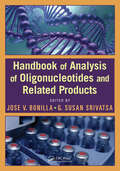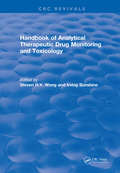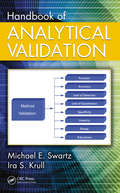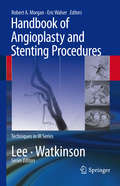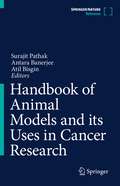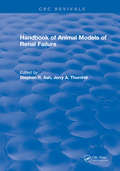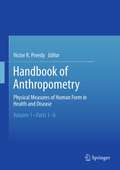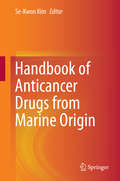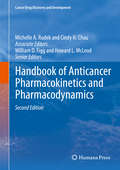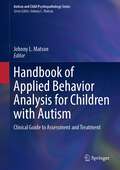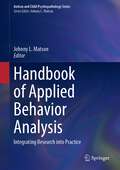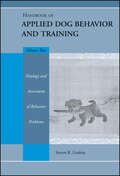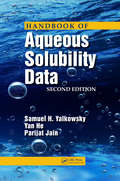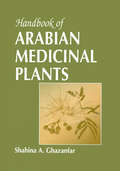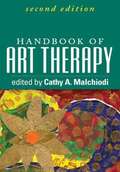- Table View
- List View
Handbook of Analysis of Oligonucleotides and Related Products
by Jose V. Bonilla G. Susan SrivatsaOligonucleotides represent one of the most significant pharmaceutical breakthroughs in recent years, showing great promise as diagnostic and therapeutic agents for malignant tumors, cardiovascular disease, diabetes, viral infections, and many other degenerative disorders. The Handbook of Analysis of Oligonucleotides and Related Products is an essen
Handbook of Analytical Therapeutic Drug Monitoring and Toxicology (CRC Press Revivals)
by Steven H.Y. Wong Irving SunshineAdapting modern advances in analytical techniques to daily laboratory practices challenges many toxicologists, clinical laboratories, and pharmaceutical scientists. The Handbook of Analytical Therapeutic Drug Monitoring and Toxicology helps you keep abreast of the innovative changes that can make your laboratory - and the studies undertaken in it - a success. This volume simplifies your search for appropriate techniques, describes recent contributions from leading investigators, and provides valuable evaluations and advice.
Handbook of Analytical Validation
by Michael E. Swartz Ira S. KrullWritten for practitioners in both the drug and biotechnology industries, the Handbook of Analytical Validation carefully compiles current regulatory requirements on the validation of new or modified analytical methods. Shedding light on method validation from a practical standpoint, the handbook:Contains practical, up-to-date guidelines for analyti
Handbook of Anatomical Models for Radiation Dosimetry (Series in Medical Physics and Biomedical Engineering)
by Keith F. Eckerman Xie George XuOver the past few decades, the radiological science community has developed and applied numerous models of the human body for radiation protection, diagnostic imaging, and nuclear medicine therapy. The Handbook of Anatomical Models for Radiation Dosimetry provides a comprehensive review of the development and application of these computational mode
Handbook of Angioplasty and Stenting Procedures
by Robert A. Morgan Eric WalserThe Techniques in Interventional Radiology series of handbooks describes in detail the various interventional radiology procedures and therapies that are in current practice. The series comprises four titles, which in turn cover procedures in angioplasty and stenting, transcatheter embolization and therapy, biopsy and drainage and ablation. Each book is laid out in bullet point format, so that the desired information can be located quickly and easily. Interventional radiologists at all stages, from trainees through to specialists, will find this book a valuable asset for their practice. The Handbook of Angioplasty and Stenting Procedures first discusses the basic tools and principles of these procedures, then moves onto describing each operation that can be performed using these techniques. Dr. Robert Morgan is Consultant Radiologist at St Georges' Hospital, London, UK, and Dr. Eric Walser is Professor of Radiology at the Mayo Clinic in Florida, USA.
Handbook of Animal Diversity
by Richard E. BlackwelderThis book is a summary of the diversity between and within the classes of animals. It is intended for reference on all aspects of animals that can be studied comparatively, but such comparisons requires that the occurrence of the feature in question beknown for more than just one or two groups. It is in large part a book on invertebrate animals because the vertebrates from only a small part of the diversity of animals.
Handbook of Animal Models and its Uses in Cancer Research
by Surajit Pathak Antara Banerjee Atil BisginThis reference book compiles together different animal models in cancer research. It provides knowledge and a better understanding of the advancement of the molecular and cellular mechanisms associated with the progression, formation, and clinical results of various types of cancer from the evidence collected from animal models utilized for cancer research. It discusses animal models for screening anti-cancer drugs and exploration of gene therapy. It presents different methods used to construct cancer animal models and the progress of each animal model in tumor research. The book also highlights the applications of genetic engineering, including CRISP/Cas9, in designing and developing animal models for cancer research. Further, it discusses strategies for modeling animals for investigating growth, metastasis, tumor-associated inflammation and microenvironment, cancer stem cells, tumor heterogeneity, and therapeutic resistance. This book is s a valuable resource for basic and translational cancer researchers, clinicians, and health care.
Handbook of Animal Models in Transplantation Research
by Donald V. Cramer Luis G. Podesta Leonard MakowkaHandbook of Animal Models in Transplantation Research is a new surgical handbook that provides detailed information concerning the transplantation of a variety of tissues in experimental animals. The text provides a practical guide for experienced investigators to develop new surgical transplantation models for application in a laboratory setting. Each chapter gives consistent descriptions of the anatomical considerations, the surgical model, and potential applications of the procedure. The organ systems covered include the heart and/or lung, liver, small bowel, kidneys, and bone marrow. The species selected for representation of each experimental model is based upon the usefulness and frequency of the model for studies in transplantation research. This book is important for all experimental surgeons, transplantation biologists, and students of surgical research.
Handbook of Animal Models of Renal Failure
by Stephen R. AshThis text presents a variety of methods of creation of renal failure, by the author‘s experience in the study and support of laboratory animal models of renal failure. This text also discusses three studies on the mechanisms of renal damage and renal failure in animal models.
Handbook of Anthropometry
by Victor R. PreedyAlthough its underlying concept is a relatively simple one--the measurement of the human body and its parts--anthropometry employs a myriad of methods and instruments, and is useful for a variety of purposes, from understanding the impact of disease on individuals to tracking changes in populations over time. The first interdisciplinary reference on the subject, the Handbook of Anthropometry brings this wide-ranging field together: basic theory and highly specialized topics in normal and abnormal anthropometry in terms of health, disease prevention, and intervention. Over 140 self-contained chapters cover up-to-date indices, the latest studies on computerized methods, shape-capturing systems, and bioelectrical impedance, data concerning single tissues and whole-body variables, and reports from different areas of the world. Chapters feature helpful charts and illustrations, cross-references to related chapters are included, and key points are presented in bullet form for ease of comprehension. Together, the Handbook's thirteen sections entail all major aspects of anthropometrical practice and research, including: Tools and techniques. Developmental stages, from fetus to elder. Genetic diseases, metabolic diseases, and cancer. Exercise and nutrition. Ethnic, cultural, and geographic populations. Special conditions and circumstances. The Handbook of Anthropometry is an invaluable addition to the reference libraries of a broad spectrum of health professionals, among them health scientists, physicians, physiologists, nutritionists, dieticians, nurses, public health researchers, epidemiologists, exercise physiologists, and physical therapists. It is also useful to college-level students and faculty in the health disciplines, as well as to policymakers and ergonomists.
Handbook of Anticancer Drugs from Marine Origin
by Se-Kwon KimThis timely desk reference focuses on marine-derived bioactive substances which have biological, medical and industrial applications. The medicinal value of these marine natural products are assessed and discussed. Their function as a new and important resource in novel, anticancer drug discovery research is also presented in international contributions from several research groups. For example, the potential role of Spongistatin, Apratoxin A, Eribulin mesylate, phlorotannins, fucoidan, as anticancer agents is explained. The mechanism of action of bioactive compounds present in marine algae, bacteria, fungus, sponges, seaweeds and other marine animals and plants are illustrated via several mechanisms. In addition, this handbook lists various compounds that are active candidates in chemoprevention and their target actions. The handbook also places into context the demand for anticancer nutraceuticals and their use as potential anti-cancer pharmaceuticals and medicines. This study of advanced and future types of natural compounds from marine sources is written to facilitate the understanding of Biotechnology and its application to marine natural product drug discovery research.
Handbook of Anticancer Pharmacokinetics and Pharmacodynamics
by Cindy H. Chau William D. Figg Michelle A. Rudek Howard L. McleodThere are many steps on the road from discovery of an anticancer drug to securing its final approval by the Food and Drug Administration. In this thoroughly updated and expanded second edition of the Handbook of Anticancer Pharmacokinetics and Pharmacodynamics, leading investigators synthesize an invaluable overview of the experimental and clinical processes of anticancer drug development, creating a single indispensable reference that covers all the steps from the identification of cancer-specific molecular targets to screening techniques and the development and validation of bioanalytical methods to clinical trial design and all phases of clinical trials. The authors have included new material on phase 0 trials in oncology, organ dysfunction trials, drug formulations and their impact on anticancer drug PK/PD including strategies to improve drug delivery, pharmacogenomics and cancer therapy, high throughput platforms in drug metabolism and transport pharmacogenetics, imaging in drug development and nanotechnology in cancer. Authoritative and up-to-date, Handbook of Anticancer Pharmacokinetics and Pharmacodynamics, 2nd Edition provides in one comprehensive and highly practical volume a detailed step-by-step guide to the successful design and approval of anticancer drugs. Road map to anticancer drug development from discovery to NDA submission Discussion of molecular targets and preclinical screening Development and validation of bioanalytical methods Chapters on clinical trial design and phase 0, I, II, III clinical trials Pharmacokinetics, pharmacodynamics, pharmacogenomics, and pharmacogenetics of anticancer agents Review of the drug development process from both laboratory and clinical perspectives New technological advances in imaging, high throughput platforms, and nanotechnology in anticancer drug development
Handbook of Antimicrobial Resistance
by Albert Berghuis Greg Matlashewski Mark A. Wainberg Donald SheppardWhile many volumes have been written about various aspects of antimicrobial resistance, this book is a comprehensive reference work. All manifestations of resistance are addressed: viral; bacterial, parasitical and fungal are given dedicated sections. The underlining molecular mechanisms, which depend not only on the microbe but on the specific drug (target), are highly diverse. This work discusses and compares the biological, biochemical and structural aspects of resistance and its evolution.
Handbook of Antioxidants (Oxidative Stress and Disease)
by Enrique Cadenas Lester PackerContains new and expanded material on antioxidants in beverages and herbal products, nitric oxide and selenium, and the effect of vitamin C on cardiovascular disease and of lipoic acid on aging, hyperglycemia, and insulin resistance! Offering over 4200 contemporary references-2000 more than the previous edition-the Second Edition of the Handbook of Antioxidants is an up-to-the-minute source for nutritionists and dietitians, cell biologists and biochemists, cardiologists, oncologists, dermatologists, and medical students in these disciplines.
Handbook of Applied Behavior Analysis Interventions for Autism: Integrating Research into Practice (Autism and Child Psychopathology Series)
by Justin B. Leaf Mary Jane Weiss Joseph H. Cihon Julia L. FergusonThis handbook addresses evidence-based practices in Applied Behavior Analysis (ABA) for individuals diagnosed with autism spectrum disorder (ASD). It provides an overview of the history of evidence-based practices and their importance as applied to the law, school settings, and factors that influence the use for treatment of ASD. Additional areas of coverage include evidence-based and non-evidence-based ABA interventions for autism as well as decision-making ethics related to these treatments. In addition, the book addresses cultural considerations as they relate to these treatments and examines procedural aspects of ABA interventions for autism. Key ABA treatments addressed include: Discrete trial teaching. Pivotal response training. Video modeling. Parent-mediated intervention. Early Start Denver Model, PEAK, PECS, and AAC. Script fading/activity schedules and differential reinforcement/extinction. Response interruption and redirection. Self-management and self-monitoring. The Handbook of Applied Behavior Analysis Interventions for Autism is a must-have resource for researchers, professors, and graduate students as well as clinicians, therapists, and other professionals across such interrelated disciplines as clinical child, school, and developmental psychology, child and adolescent psychiatry, social work, rehabilitation medicine/therapy, pediatrics, and special education.
Handbook of Applied Behavior Analysis for Children with Autism: Clinical Guide to Assessment and Treatment (Autism and Child Psychopathology Series)
by Johnny L. MatsonThe handbook examines the latest advancements in applied behavior analysis (ABA) as the preferred method of treatment for children diagnosed with autism spectrum disorder (ASD). It synthesizes the most current research data and trends with best-practice interventions to form a comprehensive, state-of-the-art resource. The handbook reviews ABA research and practices in depth and identifies the interventions most relevant to children across the autism spectrum. Key areas of coverage include: Foundations of applied behavior analysis.ABA treatments for disorders comorbid with autism spectrum disorder.Functional assessment for children with autism.Operational definitions as well as observing and recording data for children with autism.The relationship of measures of psychopathology and applied behavior analysis.Transitioning across tasks for children with autism, including toe walking, feeding problems, and self-help issues.Anxiety, depression, and ADHD in children with autism. The Handbook of Applied Behavior Analysis for Children with Autism is an essential reference for researchers, clinicians and graduate students as well as clinicians, therapists, and other practitioners across such interrelated disciplines as clinical child, school, and developmental psychology, child and adolescent psychiatry, social work, rehabilitation medicine/therapy, pediatrics, and special education.
Handbook of Applied Behavior Analysis, Second Edition
by Wayne W. Fisher, Cathleen C. Piazza and Henry S. RoaneWidely regarded as the authoritative work on the principles and practice of applied behavior analysis (ABA), this indispensable volume is now in a revised and expanded second edition. Leading experts present evidence-based procedures for supporting positive behaviors and reducing problem behaviors with children and adults in diverse contexts. Chapters delve into applications in education, autism treatment, addictions, behavioral pediatrics, and other areas. Covering everything from behavioral assessment and measurement to the design and implementation of individualized interventions, the Handbook is a complete reference and training tool for ABA practitioners and students. New to This Edition *Incorporates key advances in research, theory, and clinical practice. *Chapters on additional applications: school consultation, pediatric feeding disorders, and telehealth services. *Chapters on quantitative analysis of behavior (matching and behavioral momentum theory) and behavioral economics. *Updated discussions of professional issues, ABA certification, and technology tools.
Handbook of Applied Behavior Analysis: Integrating Research into Practice (Autism and Child Psychopathology Series)
by Johnny L. MatsonThis book provides comprehensive coverage of applied behavioral analysis (ABA). It examines the history and training methods of ABA as well as related ethical and legal issues. The book discusses various aspects of reinforcement, including social reinforcers, tangible reinforcers, automatic reinforcement, thinning reinforcers, and behavioral momentum. It addresses basic training strategies, such as prompts and fadings, stimulus fading, and stimulus pairing and provides insights into auditory/visual discrimination, instructional feedback, generalization, error correction procedures, and response interruption. In addition, the book addresses the use of ABA in education and explores compliance training, on-task behavior, teaching play and social skills, listening and academic skills, technology, remembering and cognitions, picture-based instruction, foreign language instruction, teaching verbal behavior, public speaking, and vocational skills. In addition, the book covers treatments for tics, trichotillomania, stereotypies, self-injurious behavior, aggression, and toe walking. It also addresses ABA for special populations, including individuals with autism, ADHD, substance abuse, and intellectual disabilities.Featured areas of coverage include:Basic assessment methods, such as observing behavior, treatment integrity, social validation, evaluating physical activity, measuring sleep disturbances, preference assessment, and establishing criteria for skill mastery.Functional assessment, including how to quantify outcomes and evaluate results, behaviors that precede and are linked to target behaviors, and treatments.Treatment methods, such as token economies, discrete trial instruction, protective equipment, group-based and parent training as well as staff training and self-control procedures.Health issues, including dental and self-care, life skills, mealtime and feeding, telehealth, smoking reduction and cessation, and safety training.Leisure and social skills, such as cellphone use, gambling, teaching music, sports and physical fitness.The Handbook of Applied Behavior Analysis is a must-have reference for researchers, professors, and graduate students as well as clinicians, therapists, and other professionals in clinical child and school psychology, child and adolescent psychiatry, social work, behavioral therapy and rehabilitation, special education, developmental psychology, pediatrics, nursing, and all interrelated disciplines.
Handbook of Applied Dog Behavior and Training, Adaptation and Learning: Adaptation And Learning
by Steven R. LindsayTwenty-five years of study and experience went into the making of this one-of-a-kind reference. Veterinarians, animal scientists, dog owners, trainers, consultants, and counsellors will find this book a benchmark reference and handbook concerning positive, humane management and control of dogs. Reflecting the author's extensive work with dogs, this book promises thorough explanations of topics, and proven behavioural strategies that have been designed, tested, and used by the author. More than 50 figures and tables illustrate this unique and significant contribution to dog behaviour, training, and learning.
Handbook of Applied Dog Behavior and Training, Etiology and Assessment of Behavior Problems
by Steve LindsayHandbook of Applied Dog Behaviour and Training, Volume two: Etiology and Assessment of Behaviour Problems is the definitive reference for dog trainers, behaviourists, breeders and veterinarians. Coupled with Volume one, this text provides theoretical and practical framework for understanding the development and treatment of dog behaviour problems. Topics covered include Fear, anxiety and phobias, Separation-related problems, Hyperactivity, and Dominance, territorial, and fear-related aggression. The focus is to present and evaluate the relevant applied and scientific literature, and to highlight what remains to be learned, while the author introduces alternative ways for analysing and understanding the etiology of dog behaviour problems.
Handbook of Applied Dog Behavior and Training, Procedures and Protocols: Procedures And Protocols
by Steven R. LindsayThe Handbook of Applied Dog Behavior and Training series provides a coherent and integrated approach to understanding and controlling dog behavior. In Volume 3, various themes introduced in Volumes 1 and 2 are expanded upon, especially causally significant social, biological, and behavioral influences that impact on the etiology of behavior problems and their treatment. Ethological observations, relevant behavioral and neurobiological research, and dog behavior clinical findings are reviewed and critiqued in detail. Many of the training concepts, procedures, and protocols described have not been previously published, making this book a unique contribution to dog behavior and training literature.
Handbook of Aqueous Solubility Data
by Samuel H. Yalkowsky Yan He Parijat JainOver the years, researchers have reported solubility data in the chemical, pharmaceutical, engineering, and environmental literature for several thousand organic compounds. Until the first publication of the Handbook of Aqueous Solubility Data, this information had been scattered throughout numerous sources. Now newly revised, the second edition of
Handbook of Arabian Medicinal Plants
by Shahina A. GhazanfarThe Handbook of Arabian Medicinal Plants is the first illustrated reference on the uses of plants in the Arabian Peninsula. It documents and preserves the existing knowledge in a region where social patterns are rapidly changing. The book emphasizes the need for preserving social and cultural patterns.
Handbook of Art Therapy, Second Edition
by Cathy A. MalchiodiWidely regarded as the standard reference in the field, this handbook provides a complete overview of art therapy, from theory and research to practical applications. Leading practitioners demonstrate the nuts and bolts of arts-based intervention with children, adults, families, couples, and groups dealing with a wide range of clinical issues. Rich with illustrative case material, the volume features 110 sample drawings and other artwork. The inclusion of diverse theoretical approaches and practice settings makes the Handbook eminently useful for all mental health professionals interested in using art in evaluation and treatment. New to This Edition Incorporates the latest clinical applications, methods, and research. Chapter on art materials and media (including uses of new technologies). Chapters on intervening with domestic violence survivors, bereaved children, and military personnel. Expanded coverage of neuroscience, cultural diversity, and ethics.
Handbook of Artificial Intelligence in Healthcare: Vol 2: Practicalities and Prospects (Intelligent Systems Reference Library #212)
by Lakhmi C. Jain Yen-Wei Chen Chee-Peng Lim Ashlesha Vaidya Charu MahorkarArtificial Intelligence (AI) has transformed many aspects of our daily activities. Health and well-being of humans stand as one of the key domains where AI has achieved significant progresses, saving time, costs, and potentially lives, as well as fostering economic resilience, particularly under the COVID-19 pandemic environments. This book is a sequel of the Handbook of Artificial Intelligence in Healthcare. The first volume of the Handbook is dedicated to present advances and applications of AI methodologies in several specific areas, i.e., signal, image, and video processing as well as information and data analytics. In this second volume of the Handbook, general practicality challenges and future prospects of AI methodologies pertaining to healthcare and related domains are presented in Part 1 and Part 2, respectively. It is envisaged that the selected studies will provide readers a general perspective on the issues, challenges, and opportunities in designing, developing, and implementing AI-based tools and solutions in the healthcare sector, bringing benefits to transform and advance health and well-being development of humans..
